The Daily Bread of Rome: The Apple of Discord Between Romans and the Bakers
Bread was an essential part of the Roman diet, especially for the lower classes. It wasn’t just a staple but also reflected social status and culture, varying in type and quality depending on the person’s wealth and occupation.
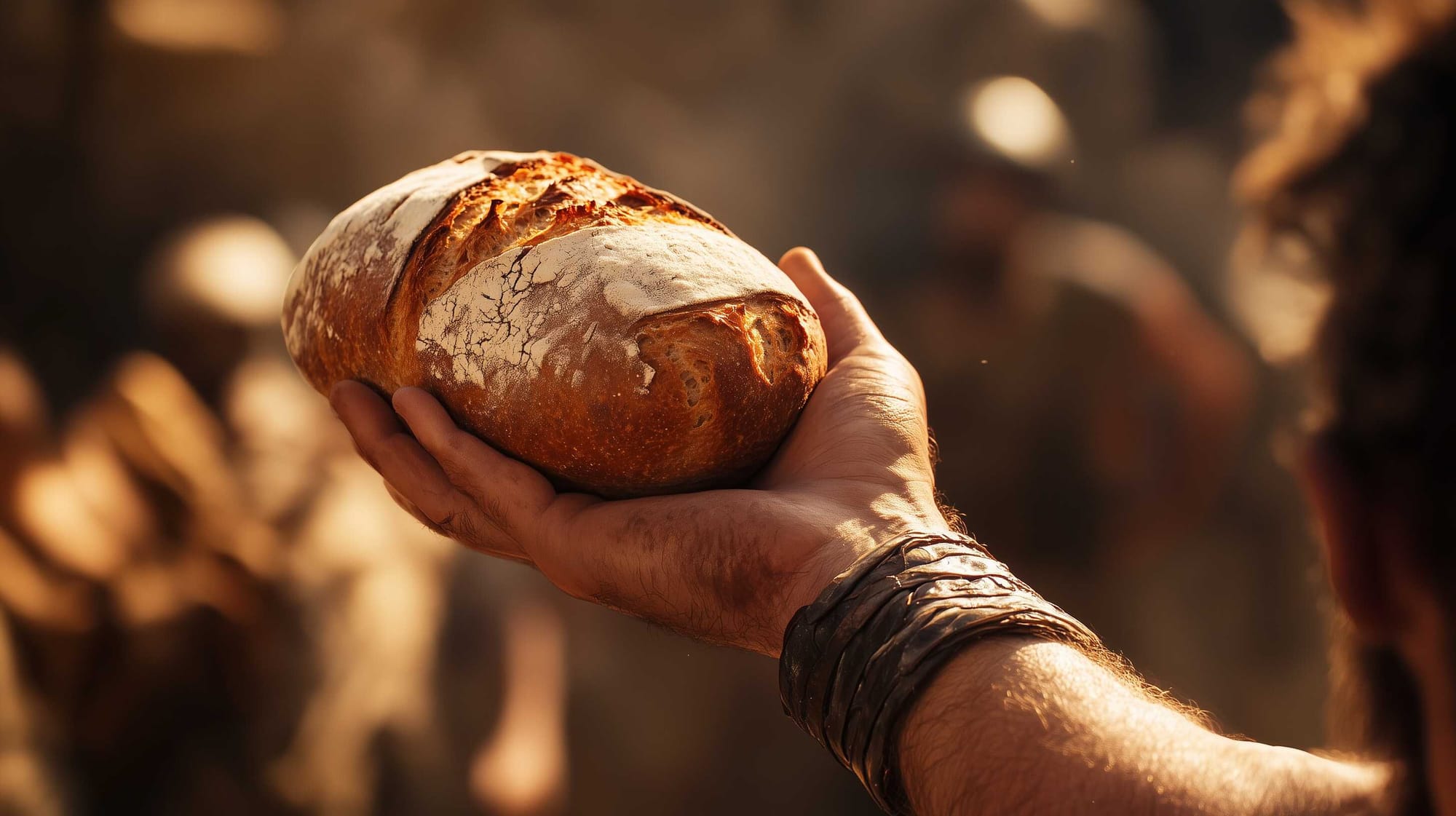
Bread and Baking in the Heart of the Roman Empire
Bread held a central role in Roman daily life, fueling the development of bread-making industries that required extensive trade, organization, and labor. Various types of bread emerged, catering to diverse tastes and budgets, establishing a social hierarchy of grains, flours, and loaves. The characteristics of different grains, such as ease of cultivation, milling, and bread quality, were well-documented by ancient writers who associated these traits with the communities that consumed them.
In Rome's early days, however, bread wasn’t as prominent. For the first five centuries, Romans relied on puls, a basic porridge made from emmer grain, salt, and water. This simple dish, paired with vegetables, broths, and garum, defined the Roman diet, with meat rarely featured outside of special occasions or hardships.
Although emmer was easy to grind by hand, its flour didn’t produce quality bread, resulting in dense and flavorless loaves. Consequently, the Roman diet was labeled as unsophisticated by ancient writers, who referred to Romans dismissively as pultiphagonides or “porridge eaters.” This reliance on emmer was partly due to the limited and challenging farmland around Rome, which was cultivated by small farming families whose workforces were frequently depleted by military conscription.
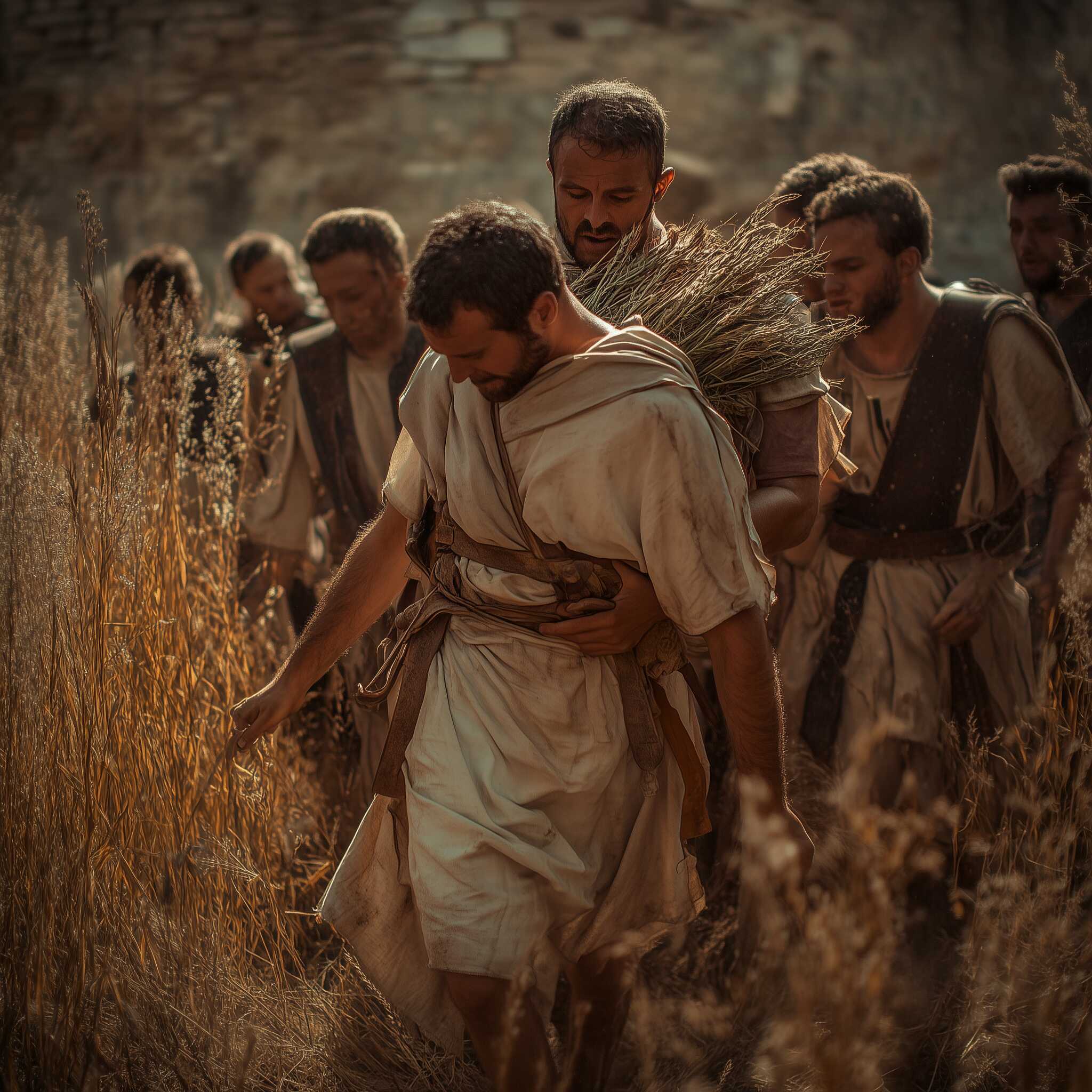
Such interruptions forced Roman agriculture to focus on hardy, low-maintenance crops.
A possible representation of two Roman farmer brothers, one of them being conscripted into the army. Illustration: Midjourney
However, Rome’s conquests in the Macedonian War (171-168 BCE) transformed this situation, expanding its territories and bringing new land, labor, and crops, including wheat and spelt—ideal grains for quality bread—into Roman agriculture. Although puls remained a part of the diet, it was soon overshadowed by wheat bread, which was easier to produce, customize, store, and transport.
By the mid-second century BCE, wheat bread had become the dominant staple across the empire, a sign of Rome’s agricultural and cultural reach. With annexed lands and resources, Rome could mass-produce bread, making it not only a dietary staple but a symbol of Roman civilization.
Symbolic Significance of Bread in Ancient Roman Writings
Although a staple food, bread held symbolic significance for Rome's elite and featured widely as a metaphor across various literary genres aimed at affluent audiences. In the 1st century BCE, as Rome’s expanding territories brought a greater variety of exotic imports, elite dining became a showcase of wealth and status.
Writers used food customs as a lens to critique the shift from revered Republican virtues to the indulgence of Imperial luxury. Just as staple grains once symbolized societal strength, extravagant feasts now revealed moral decay, leaving readers to question who or what was truly being consumed. Bread, too, became part of this symbolic structure: fine wheat breads graced the banquets of the wealthy, contrasting with the simpler, round loaves typical of modest, lower-class meals.
When grain shortages arose due to political instability, crop failures, or financial manipulation, bakers and emperors alike faced public outrage. Bread thus served both literally and metaphorically as a catalyst for social stability or unrest, making it an ideal literary device to explore the values and moral tensions across Roman social classes.
“Then immediately he lays it [the dough] out onto a smooth table, pours warm water on it and now draws together and mixes the liquid and the flour crossing from one side to the other in order to make a hard blanket through the action of hand and liquid, now and then sprinkling a little heap of salt.
And now kneaded he lifts up his hard work and with open palms spreads it out into a circle and brands it stamping out equal separate quarters.
Then he brings it from there to the hearth (Scybale had beforehand cleaned a suitable place) and he tests and protects it above the fuelled fire.
And with Vulcan [heat] and Vesta [hearth] playing their part, Simylus meanwhile is not inactive in that empty hour, but instead seeks another resource for himself, with not only one palate to please, he brings together a meal which Ceres herself would be grateful for.”
Virgil, Moretum
The poem Moretum uses the humble act of bread-making to reflect Augustan ideals of unity, discipline, and societal roles. The story follows a farmer, Simylus, who rises early to make a simple round loaf, embodying the virtues of patience, labor, and community. His preparation of bread, with its blending of water and flour, symbolizes the cohesion of masculine and feminine, and the unity of social classes, connecting themes of agricultural, sexual, and military duties.

The language of the poem layers words with dual meanings, linking bread-making with broader metaphors of land, fertility, and honor.
A possible representation of Roman Goddess Vesta, holding and enjoying the smell of a fresh loaf of bread. Illustration: Midjourney
The final loaf becomes a symbol of social harmony, as Simylus relies on his slave, Scybale, and the deities Ceres, Vulcan, Vesta, and Minerva, who each contribute to the bread-making ritual. The detailed circular form of the bread represents order and restraint, values that align with Augustus' vision for Rome. By carefully dividing the bread with restraint, even when hungry, Simylus exemplifies the provisioning and discipline that Augustus promoted. The poem thus elevates this simple, round loaf of bread as a reflection of the essential virtues of Roman society.
The Myriad Roman Remedies Surrounding Bread
In Naturalis Historia, Pliny the Elder devotes an entire chapter to bread, highlighting its curative properties and its unique status among provisions. Bread, he argues, is Rome's most important remedy, used to treat various internal and external ailments. More than just a list of medical applications, Pliny presents bread as a symbol of social cohesion and balance, reflecting the interplay between nature, humanity, and divinity in Rome. He suggests that bread addresses not only physical ailments but also social issues within the Roman body politic.
“The very bread which forms our staple diet has almost innumerable medicinal properties.
Applied in water and oil or in rose oil it softens abscesses; in hydromel it is very soothing to indurations. In wine it is given to disperse or to compress as need may be, and, if greater strength be called for, in vinegar for those violent fluxes of phlegm which the Greeks call rheumatism, as well as for bruises and sprains.
For all purposes, however, leavened bread, of the kind called autopyrus, is the more beneficial.
In vinegar it is also applied to whitlows and to callosities on the feet. Stale bread or sailors’ bread, pounded and then baked again, checks looseness of the bowels.
For the voice of learned men, and runny catarrhs it is very beneficial to eat dry bread at breakfast. This year’s bread made of three-month wheat, applied with honey, is a very good cure for bruises on the face or scaling skin.
White bread soaked in warm or cold water affords a very light food for the infirm. From wine it is placed on swollen eyes, or with the addition of dried myrtle to blisters on the head.
Those effected by shaking should, whilst fasting, eat bread soaked in water immediately after a bath. In fact, when burnt [bread] removes the odours in the bedroom, and in wine when inserted into the sack.”
Pliny, Naturalis Historia
Pliny’s descriptions associate specific bread types with social classes and roles: white bread, tied to the elite, heals general illnesses, while wholegrain autopyrus, representing simplicity and wholesomeness, treats specific conditions. Bread types even extend to healing metaphors for soldiers and sailors, with each class-specific loaf symbolizing the social fabric. The final mention of white bread's power to cure Rome’s sickness underscores its importance as an emblem of stability and order.
Pliny's detailed analogies, linking bread with social and political symbolism, frame bread as a critical factor in maintaining the health of Rome. He uses bread’s status in society to explore the interconnectedness of Rome’s citizens and social classes, illustrating how bread unifies the city through nourishment, metaphor, and cure, aligning the natural, mortal, and divine realms. This positioning reflects an allegorical understanding of bread as a social and cultural anchor in Roman society, capable of transforming disorder into order and weakness into strength.
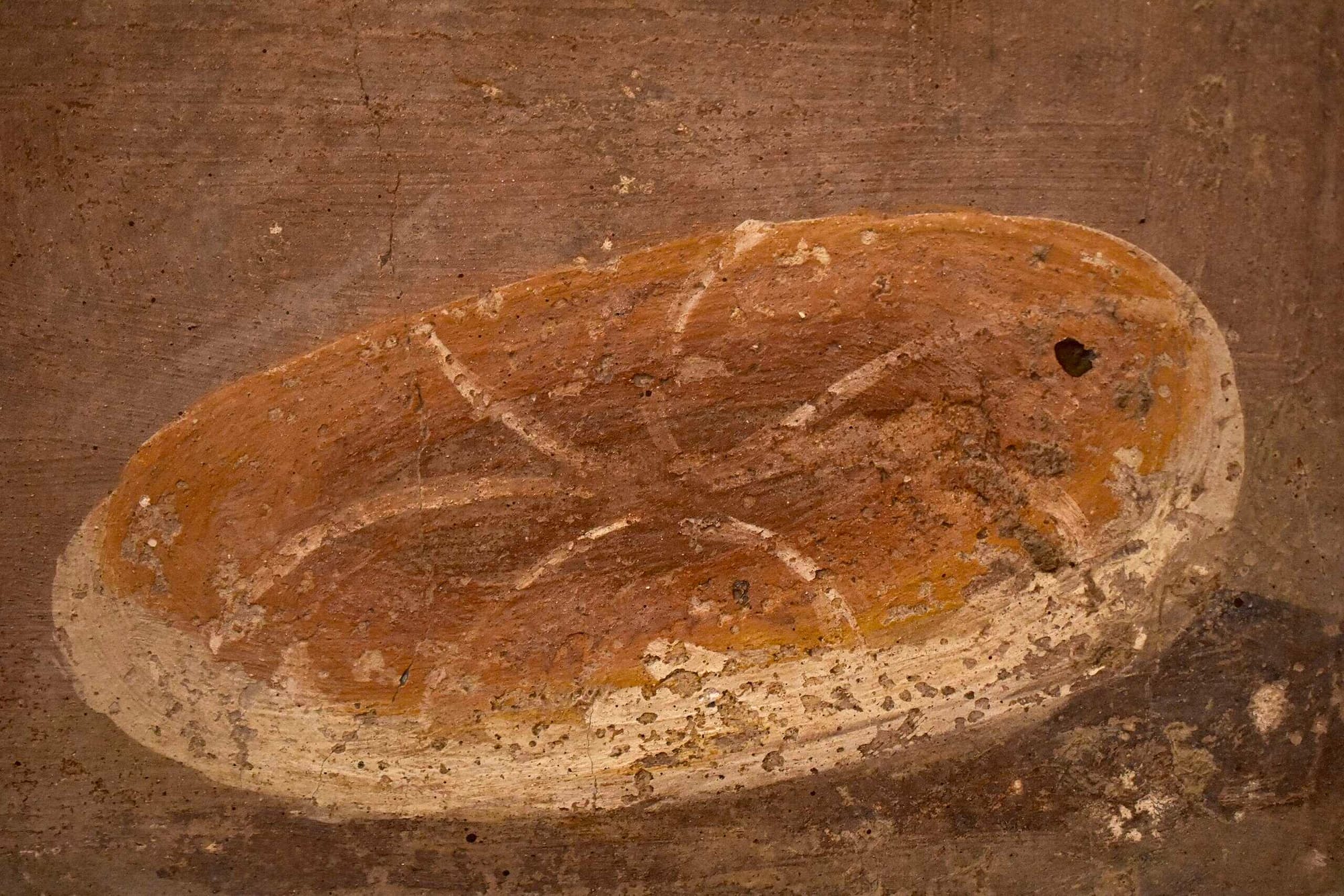
Bread in Roman Literature
Juvenal's satire directly critiques Roman society, contrasting the values of the Republic with what he saw as the corruption of his own era under various emperors. In his Saturae, Juvenal uses bread as a powerful symbol of class and morality, presenting sharp divisions between the upper and lower classes.
In one scene, a guest at a lavish banquet is served hard, rough bread, while the wealthy host enjoys soft, white loaves, symbolizing class inequality. Juvenal’s language emphasizes this divide: refined terms like "tener" and "mollio" describe the host’s bread, while terms suggesting harshness apply to the guest’s tough loaf.
“Each of the greatest houses are full of proud slaves.
Behold, another.
How far his mutters about hardly breakable bread reach, already a solid mouldy morsel of dust-flour, which shakes molars, permitting no small pieces (to be bitten).
But the tender and white and soft wheat form is saved for the master.
The right hand is mindful of being restrained; Respect is saved for this breadbasket.
Yet imagine you are imprudent [enough], there is always one who will reprimand you: “Be accustomed, impertinent guest, to satisfy yourself from the right basket and colour of your (designated) bread.”
Juvenal – Saturae
Juvenal uses bread's texture and appearance to signify social stratification—white bread for the elite and coarse barley for the poor. This visual cue reinforces a hierarchy with no middle ground, highlighting a strict class divide that was mirrored in broader Roman society.
Unlike Virgil's Moretum, which shows communal labor between the farmer Simylus and his slave, Juvenal’s banquet scene excludes the gods and instead depicts wealthy Romans as self-centered, further estranging the poor. The metaphor extends as Juvenal hints that while everyone might have bread, the quality and accessibility of it are vastly unequal, sparking reflection on the “bread” denied to Rome’s lower classes.
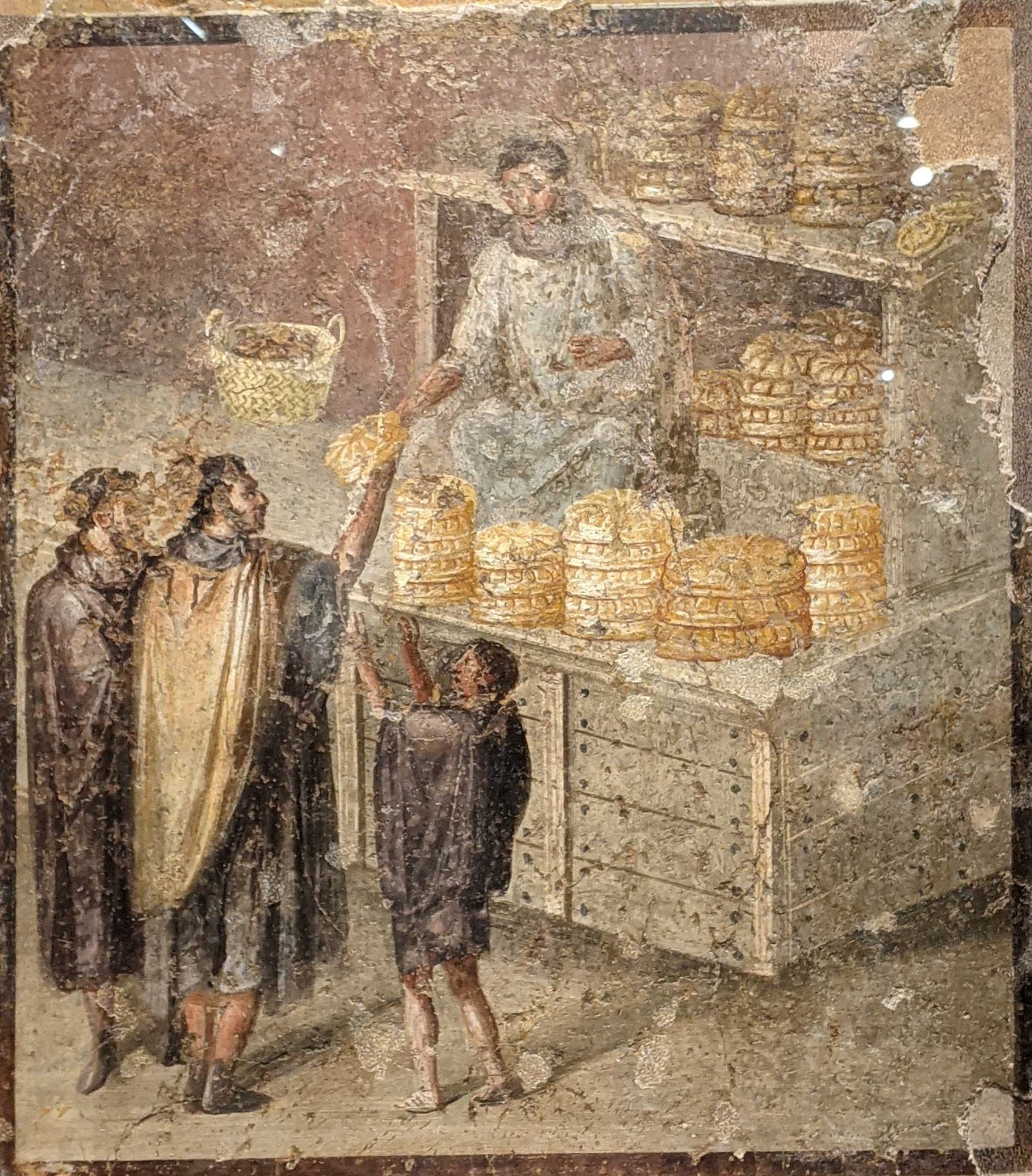
Through this, Juvenal’s work symbolically critiques the social and moral imbalances in Imperial Rome.
Pompeii fresco depicting the House of the Baker and the distribution of bread. Credits: Tyler Bell, CC BY 2.0
“At the fourth stone on the road to Campania, in a forest, he took his lunch out of which, unexpectedly, an eagle alas snatched his bread from his hand and when it had flown up to the greatest height turning back it descended gently to return it.”
Suetonius –Divus Augustus
Suetonius’ De Vita Caesarum uses bread as a recurring symbol to reveal the virtues and vices of Rome's emperors. In Caesar’s case, rebuking a baker for offering higher-quality bread to him than to guests highlights his perception of equality and humility, contrasting with the excess seen in Juvenal’s satire.
Augustus’ story is particularly powerful: while eating simple bread in a grove, an eagle (symbolizing Rome and divine authority) snatches and then returns his bread, symbolizing stability, humility, and the justified rule of Augustus following his victory over Antony. This narrative underscores Augustus as a leader guided by wisdom and humility, supported by divine approval.
Caligula, however, disrupts the bread supply for personal profit, revealing selfishness. Nero poisons enemies and restricts the poor’s access to bread, emphasizing his cruelty. Claudius is depicted more favorably; after being pelted with bread by a dissatisfied public, he stabilizes the grain supply, pacifying the people.
Through these emperors, Suetonius uses bread to critique each ruler's qualities and their impact on Rome. This symbolism aligns with themes in Moretum and Naturalis Historia, where bread represents the unity between nature, mortals, and the divine, reflecting both the character and fate of Roman society.
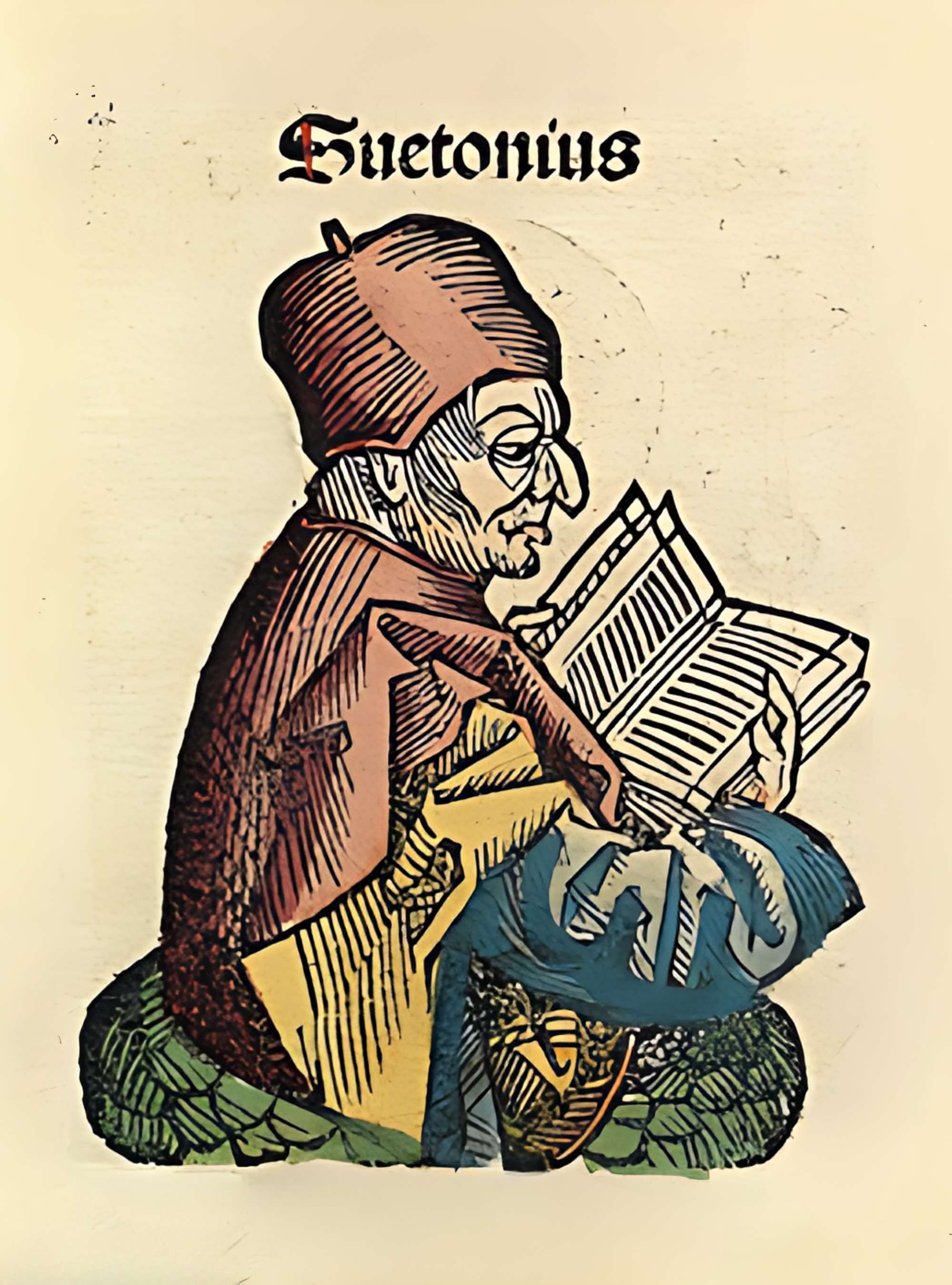
“For there is a huge dog gifted with three vast heads, monstrous and terrifying, whose thunderous throat barks with thundering jaws at the dead, who he is now, unable to harm, intimidating them in vain.
Always he lies in front of the threshold outside Proserpina’s black courts, guarding the empty house of Dis.
This one can be tamed if you offer one of the loot (breads), you will pass without difficulty and without pause to the host herself, Proserpina.
Whereby in a friendly manner and with kindness, she will persuade you to sit down gently beside her and eat a sumptuous supper.
But you must sit on the soil and sultry bread you must eat. Next announce why you have arrived, take what is offered and return, offering the small piece of bread you have left to buy off the ferocious dog.
Then give the greedy sailor the coin you saved, cross his river, and retracing your steps you will return to this sanctuary of heavenly stars.”
Apuleius –Metamorphoses
In Metamorphoses, Apuleius continues the symbolic role of bread as a link between mortals and the divine, exploring themes of humility, protection, and transformation.
In the story of Eros and Psyche, the goddess Venus challenges Psyche with impossible tasks to prove her worth, including a journey to the underworld, armed with only simple loaves of bread. These loaves serve as protective talismans, allowing Psyche safe passage, sustenance, and payment in the realm of the dead. Bread here transcends its basic form, becoming a means for Psyche to navigate danger and return unharmed.
This portrayal aligns with other Roman works that use bread as a symbol of stability, hierarchy, and divine favor. In Psyche’s trials, the humble loaves emphasize her purity and self-discipline rather than her social status. Venus’ restriction of Psyche to basic bread underscores its association with low status, mirroring Juvenal's satire.
Through Apuleius’ narrative, bread emerges as a powerful equalizer, protecting even against divine schemes, reinforcing the notion that the simplest food can overcome the greatest obstacles. (Sung, Drawn and Quartered: The Roman Ideogram of Bread (Part 1), by Bunny Waring, School of History, Classics and Archaeology, Newcastle University)
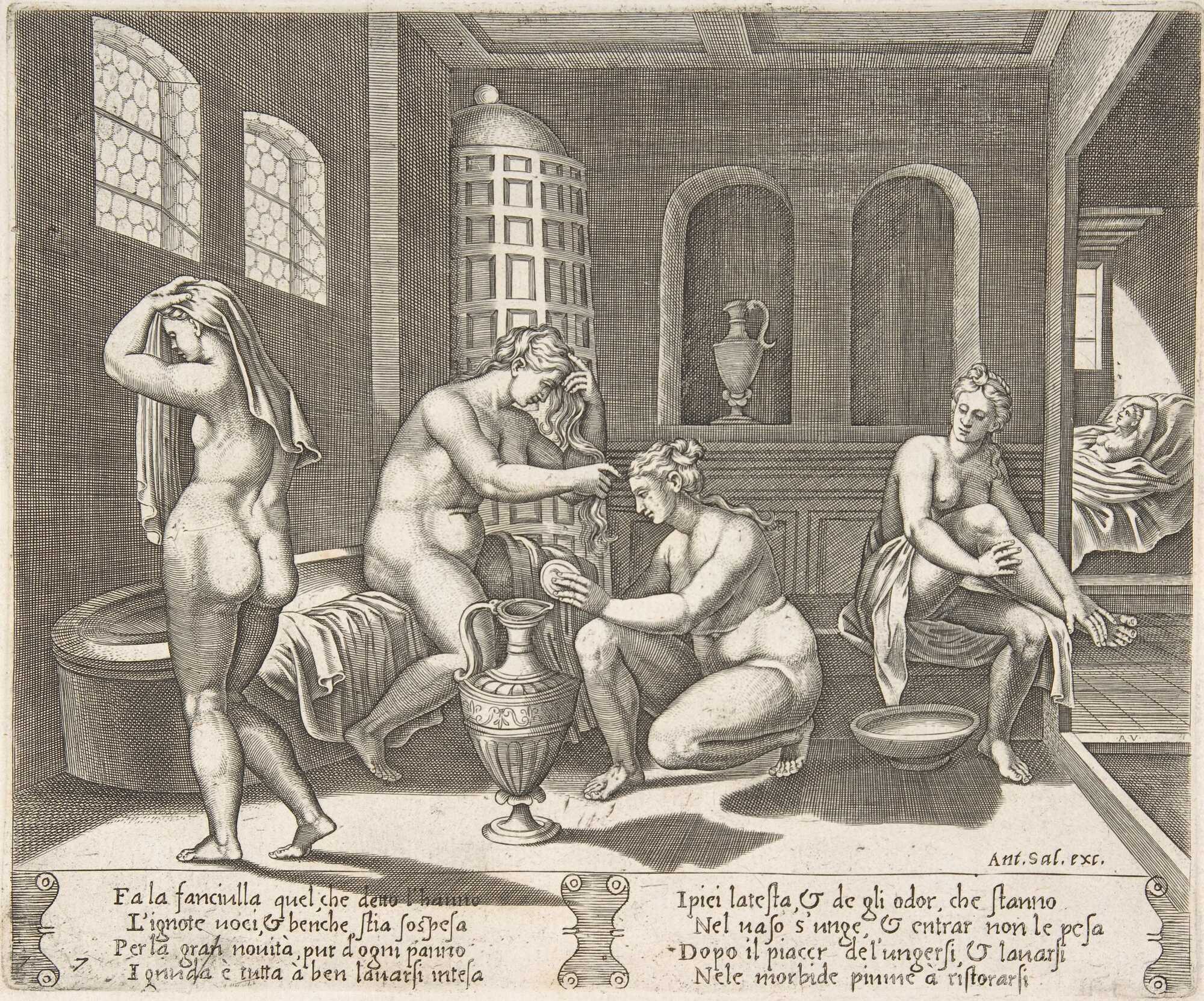
Bread, Bakers and Bakeries in Ancient Rome
During the Roman period, bread-making saw significant advancements. The emergence of commercial baking in cities like Rome, Ostia, Herculaneum, and Pompeii led to the development of new bread-making techniques and equipment to meet the needs of a growing urban population.
As reliance on bakers increased, upper-class Romans became uneasy about depending on a working-class profession to sustain urban stability in Roman Italy. Bread-making transformed significantly in the Roman period, moving from a simple, home-based activity to a sophisticated commercial industry.
Cato the Elder’s second-century BCE recipe for kneaded bread—"Wash your hands and a bowl thoroughly. Pour meal into the bowl, add water gradually, and knead thoroughly. When it is well kneaded, roll out and bake under a crock"—captures bread's fundamental ingredients, but belies the later complexity of the profession and technology involved in bread production.
In early Rome, bread was made at home, but by the second century BCE, with rapid urban population growth in cities like Rome, Pompeii, and Ostia, commercial bakeries became essential to meet rising demand. Pliny the Elder noted there were no bakers in Rome before the Third Macedonian War (171–168 BCE), though mass-produced bread became indispensable as more Roman families lacked resources to make it themselves.
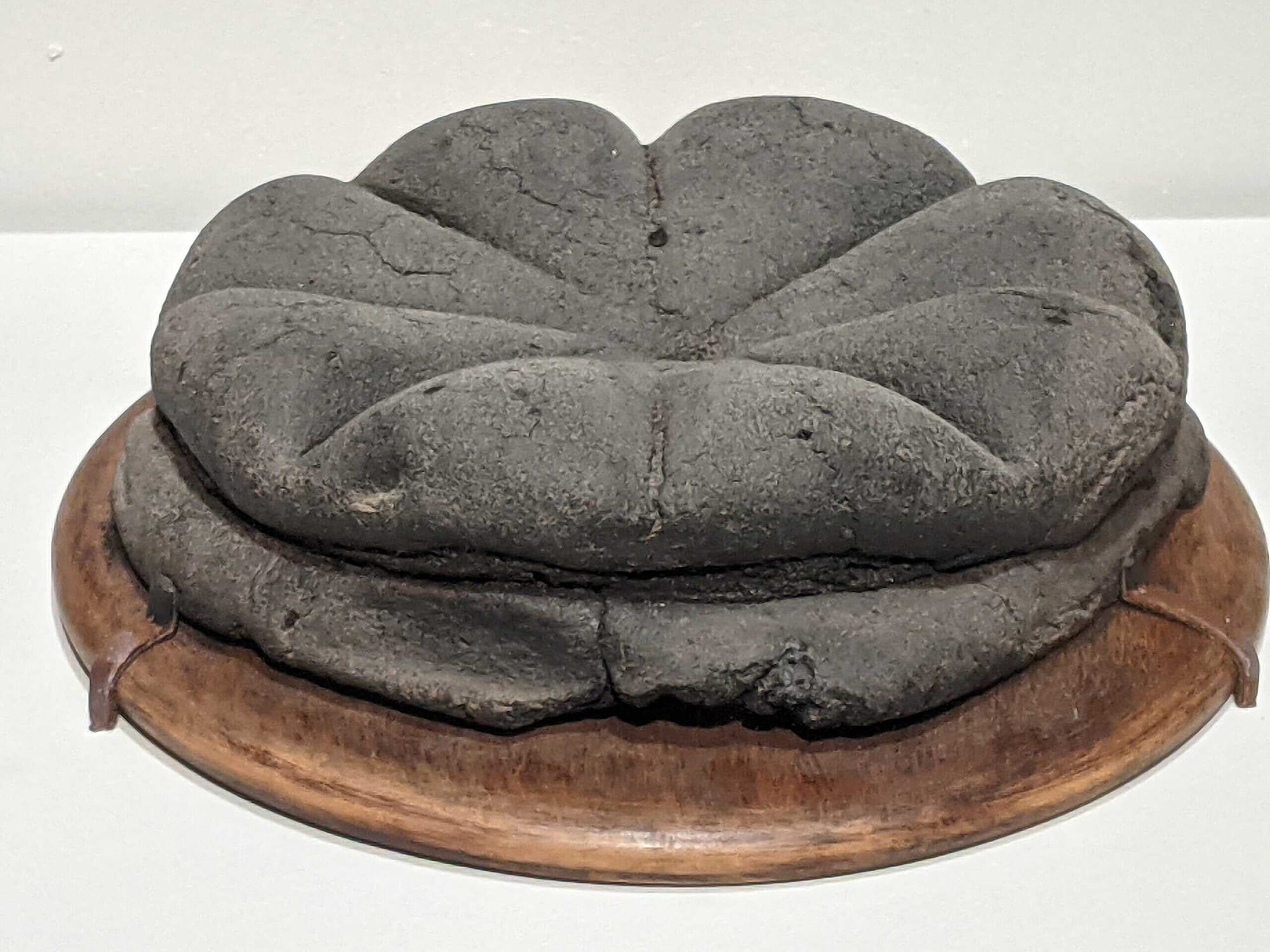
This shift freed individuals from home baking and allowed them more time for other pursuits. Bread became not only a staple food but also a powerful symbol of Rome’s stability, as it was affordable, transportable, and distributed as part of a grain dole to Rome’s poorer population.
Bread production involved numerous stages beyond Cato's simple instructions, including grain storage, milling, sifting, kneading, leavening, and baking. The rise of bakeries introduced distinctions in bread quality tied to social status; finer, white bread was reserved for the wealthy, while darker, coarser loaves were consumed by the lower classes.
The archaeological evidence, especially from well-preserved sites like Pompeii, Ostia, and Herculaneum, provides insight into Roman bread-making practices, showing specialized equipment like ovens, millstones, kneading machines, and baking tables in nearly 40 bakeries in Pompeii alone. Though early excavation reports are limited, they reveal that bread-making was both technologically advanced and socially significant in ancient Rome.
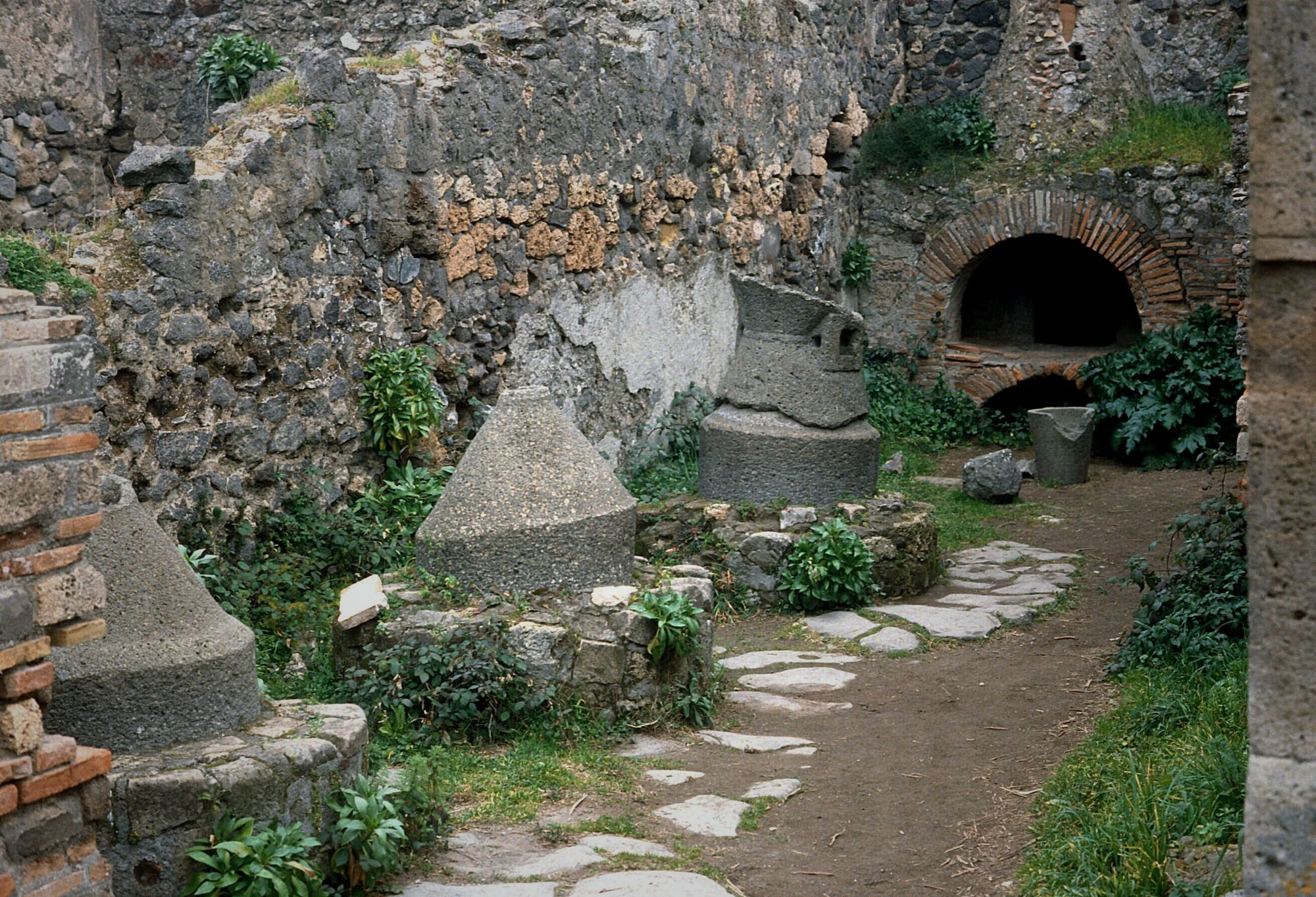
The Pistor, aka The Baker
Roman bakers, or pistores, played a crucial role in Rome's social, economic, and political growth, though evidence of their work and history is sparse. Due to this scarcity, few modern studies have focused exclusively on the pistor profession. While significant reforms in food production, specifically in the baking trade, took place during Late Antiquity, there is limited documentation from this period until the start of the Principate, where most existing evidence on Roman bakers is found.
According to Pliny in his Naturalis Historia, the term pistor derives from the Latin word pinsere, meaning "to pound," referring to the grinding motion required to mill wheat. Originally, bread was baked at home until around 171 BCE, when professional millers began moving into town centers (as already mentioned above).
These millers eventually assumed the role of bakers, taking over the entire bread-making process, although they retained the name pistor, which initially referred to their milling activity. Varro also mentions this shift in terminology in his work, De Lingua Latina:
“The pilum ‘pestle’ is so named because with it they pisunt ‘pound’ the spelt, from which the place where this is done is called a pistrinum ‘mill’ and from that afterwards pistrina ‘bakery’ and pistrix ‘woman baker,’ words used in Lucilius’s City”
Initially, millers and bakers were considered the same, but over time, the professions diverged. Millers, known as molitor, molinarius, or molendinarius, handled milling, while bakers, focused on baking. The title pistor remained with bakers even as technology like donkey mills reduced their milling duties.
Pistores came from diverse backgrounds. For Roman aristocrats, owning a slave baker was a mark of sophistication, while some freeborn bakers ran large-scale operations, employing freedmen and slaves. For instance, Marcus Iunius Pudens was a successful baker known for selling a special bread type in bulk. Female bakers, or pistrix, also existed, as noted by Varro and Lucilius.
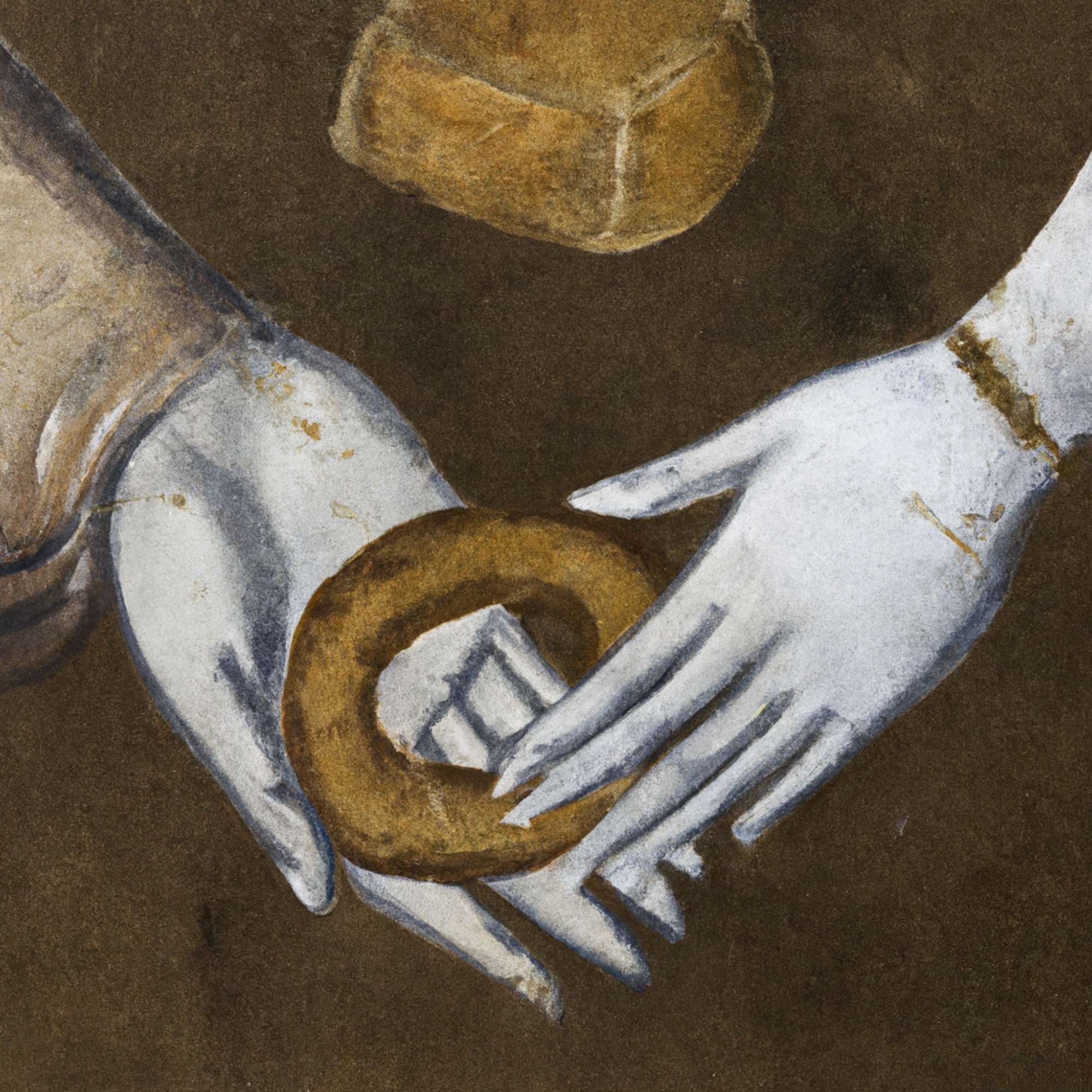
A baker’s daily routine was demanding, involving milling, baking, selling bread, and managing animals in the bakery.
A detail of a Roman painting in Segóbriga, of a person handing bread to another. Credits: GonzaloPerezDeGaldeano, CC BY-SA 4.0
Since bread was a perishable staple, bakers had to ensure a continuous fresh supply, meeting the needs of Rome’s urban residents who relied on bakeries for daily sustenance. Bakers often worked through the night, as Martial vividly described, rising early to prepare fresh bread for the morning. This made bakeries economically essential to the urban fabric of Rome, particularly for the majority who couldn’t afford home baking and depended on ready-made bread.
Roman Bakers causing Social Tension
In ancient Rome, bakers were often looked down upon, particularly by the upper classes, despite their crucial role in providing bread. The prejudice against pistores reflects broader class anxieties about reliance on trade. In De Officiis, Cicero criticized tradespeople, including bakers, whom he saw as "sordid" due to their dependence on consumer transactions, which he believed subordinated them to others.
Ancient literature frequently portrayed bakers as untrustworthy, greedy, and even morally deviant. For example, Plautus associated pistores with prostitutes, while Socrates of Constantinople recounted a likely fictional tale of bakers entrapping people in taverns and forcing them to work in bakeries.
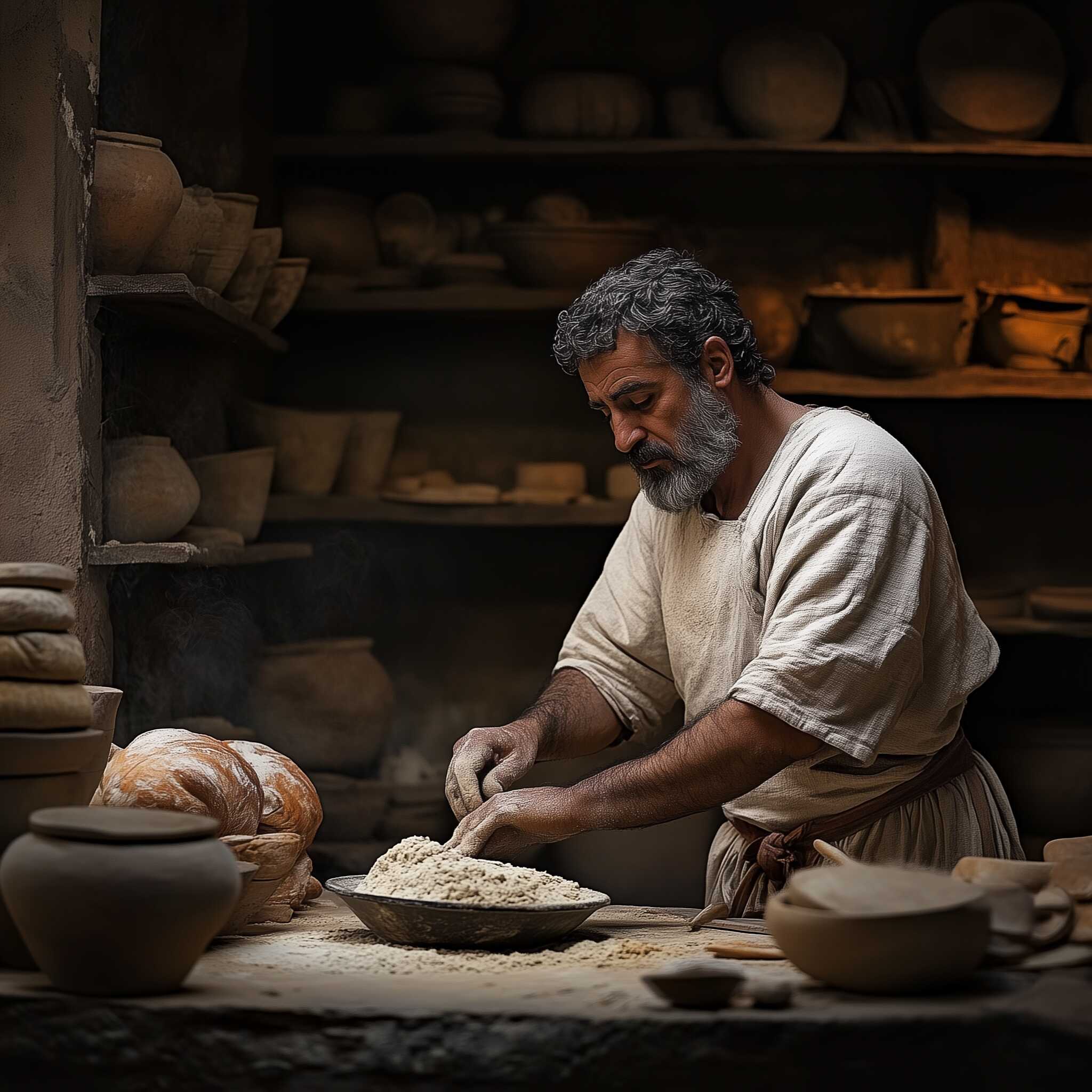
This negative view partly arose from elite Romans' concerns over the dependence of the population on lower-class bakers, who controlled the supply of an essential food.
A possible representation of a Roman baker, preparing a bread. Illustration: Midjourney
Wealthier Romans often built their own small bakeries, viewing them as "useful expenses" to avoid relying on outside bakers. However, some writers, like Juvenal, highlighted the high demand for baking as a way to make quick profits, sometimes attracting even poets to the trade. Despite this, Martial critiqued bakers’ spending habits, portraying them as unable to manage their newfound wealth.
Overall, bakers in Rome carried significant social responsibility due to their control over a daily staple. This dependency fostered anxieties among the elite, as any failure of pistores could disrupt social stability, explaining the prevalent negative stereotypes against them in Roman literature. (Bread, bakers and bakeries: a study of Bread-making in Roman Italy, by Florette Cardon)





About the Roman Empire Times
See all the latest news for the Roman Empire, ancient Roman historical facts, anecdotes from Roman Times and stories from the Empire at romanempiretimes.com. Contact our newsroom to report an update or send your story, photos and videos. Follow RET on Google News, Flipboard and subscribe here to our daily email.
Follow the Roman Empire Times on social media: